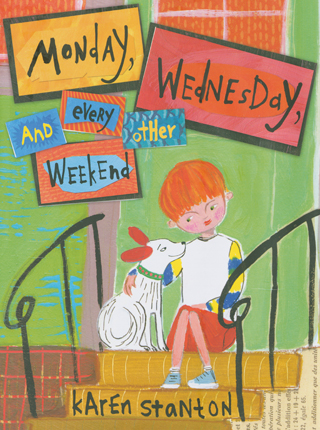Full Text Reviews: Booklist - 01/01/2014 Henry lives with each of his parents two days a week and alternates three-day weekends. Both homes have advantages, such as Mama’s Saturday-morning pancakes and Papa’s Saturday-night spaghetti. Henry and his dog, Pomegranate, have beds in both places. One morning, Pomegranate is missing. After searching at both homes, Henry finds his dog at their old house a few blocks away. He plays with the new girl there before taking Pomegranate back home. Henry narrates the story in a straightforward, unemotional manner. Stanton’s brightly colored artwork combines acrylic painting with collage elements, such as printed and painted papers. Created in a naive style, the illustrations are sometimes pleasing in their composition and use of line, while at other times, particularly when two different pictures meet at the center of a double-page spread, the effect is cluttered. Picture books with a similar theme include Claire Masurel’s Two Homes (2001) and Marian De Smet’s I Have Two Homes (2012). - Copyright 2014 Booklist. Bulletin for the Center... - 02/01/2014 “My name is Henry Cooper and I live in two houses. So does my dog, Pomegranate.” Mama’s apartment, where Henry and Pomegranate live Monday, Wednesday, and every other weekend, is colorful and lively, but a restless Pomegranate “wants to go home”; Papa’s house, where they live the rest of the time, is a feast of music and pizza, but again, “Pomegranate wants to go home.” When Pomegranate runs away one day, Henry knows where he’s gone: back to the house where they all lived together before his parents divorced. Can Henry convince him to let go of the old home for the new? The theme and the poignancy are reminiscent of Coffelt’s Fred Stays with Me! (BCCB 9/07), but here Pomegranate is proxy as much as pet, symbolizing Henry’s own wish to return to the family that’s dissolved. While his return with Pomegranate to his new life may indicate his own adjustment, the mourning for what’s gone comes through strongly, giving the title a refreshingly candid acknowledgment of loss. Acrylic and collage art hums with vivid contrasting color in a fruity palette in full-bleed scenes; figures are drawn with folk-art naïveté and gaiety, and landscapes are cheerily crowded with toylike houses in non-Euclidean shapes, so the illustrations keep the mood from descending into gloom. Plenty of kids know the experience of divorced parents and house-to-house shuttling, and they’ll embrace the device of a pet’s acting out their own feelings. DS - Copyright 2014 The Board of Trustees of the University of Illinois. School Library Journal - 02/01/2014 PreS-Gr 2—Young Henry and his dog, Pomegranate, travel from his mother's apartment to his father's house every other day. Children will notice the marked difference in the two places. Pomegranate notices as well. For instance, there is no place for a dog to dig at Papa's home. One day, the pup is missing, and Henry has a good idea where he might be found: his old house, "the place where we all used to live together." Average artwork of mixed media with bright acrylic paint and collage work of various textured scraps decorate the pages. In fact, some of the tiny scraps of words are cut from books of various languages, such as French or Spanish, which can be observed by keen eyes. Words such as "bueno" or "muy deliciosa" are inserted near the aromas wafting from the kitchen area throughout his mother's apartment. This book can fill a gap in collections because Stanton brings the story to a satisfactory conclusion with a simple understanding for children who live in two homes.—Blair Christolon, Prince William Public Library System, Manassas, VA - Copyright 2014 Publishers Weekly, Library Journal and/or School Library Journal used with permission. Loading...
|



